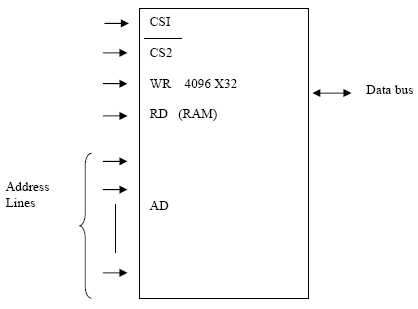|
MCS-012 : COMPUTER ORGANISATION AND ASSEMBLY LANGUAGE PROGRAMMING
Paper 1
Time : 3 hours Maximum Marks : 100
Note : Question number 1 is compulsory. Attempt any three
questions from the rest.
Q.1. a) Simplify the following Boolean function in SOP form using
K-map: F(A, B, C, D) = (0, 2, 4, 6, 8, 9, 10, 11, 12, 14)
b) A memory chip (RAM) is shown below:

Give the answer of the following questions:
(i) How many address lines are there in this chip?
(ii) How many data lines are there in this chip?
(iii) What is the word size of RAM chip?
(iv) What is the capacity of RAM chip in bytes?
(c) An instruction is stored at location 300 with its address field
at location 301.The address field has the value 400. A processor
register R1 contains the number 200. Evaluate the effective address
if the addressing mode of the instruction is:
(i) Direct
(ii) Register Indirect
(iii) Relative
(iv) Index with R1 as index register
(d) Find the range of a number for the following floating point
representation:
Base is 2
Exponent - 8 bits, bias of 8 is used
Sign bit = 1
Significant = 23 bits
Data bus Assume the normalized mantissa representation
(e) Starting from the initial value of R = 11011101, determine
the sequence of binary values in R after a logic shift-left, followed
by a circular shift-right, following by a logical shift-right and
a circular shift-left.
(f) What is a micro-instruction? Do we need all 2N combinations
of control Signals for N-bit micro-instruction? If no, then specify
the reasons. Also, differentiate between uuencoded and highly encoded
micro-instruction.
2. (a) What is master-slave flip flop? Construct a master-slave
flip flop using D flip flop and explain its working.
(b) What is RAID? List three features of RAID level 2. In Raid
technology, what are the important performance considerations? Explain
briefly.
(c) Give two reasons why a RISC processor is better than a CISC
processor.
(d) What is the purpose of queue in the bus interface unit of 8086
micro-processor? Find out the physical addresses for the following
segment register: offset. 5
(i) SS : SP = 0100h : 0020h
(ii) DS : BX = 0200h : 0100h
(iii) CS : IP = 4200h : 0123h
3. (a) Explain content addressable memory with the help of block
diagram.
(b) Show how the division of floating point numbers is done with
the help of an example.
(c) Briefly explain the working of two-pass assembler.
(d) What is the difference between hand-wired control and micro-program
control? What are the advantages and disadvantages of each method?
4. (a) Draw the state table and logic circuit for a 2-bit binary
counter using D flip-flop.
(b) Give the difference between memory mapped I/O and isolated
I/O.
(c) What is interrupt? Briefly explain the four-interrupt conditions.
(d) Write an assembly program for adding two five-byte numbers
using arrays.
5. (a) How can the subtraction operation on binary numbers be achieved
by the sequence of addition operation? Draw block diagram and then
explain.
(b) Explain the use of the following:
(i) Set-associative memory
(ii) SD RAM (c) What is a register? Explain the need of registers
in the instruction execution.
(d) What is instruction pipelining? Explain the working of instruction
pipelining in a RISC system.
|
